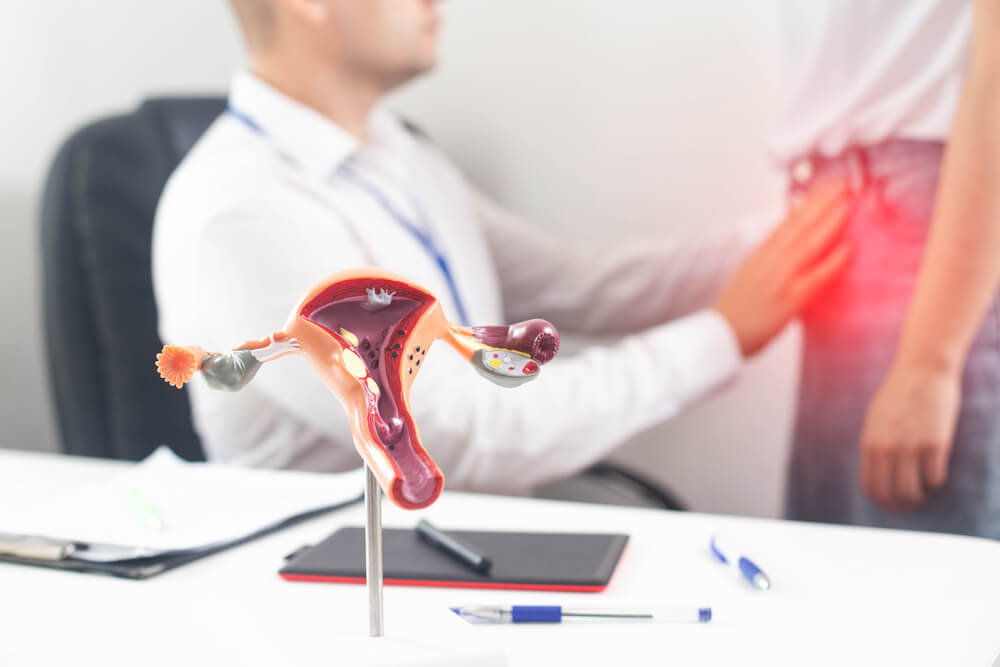Fibroids, noncancerous growths of the uterus, are a prevalent concern among women, affecting many aspects of reproductive health. One distinctive manifestation that often draws attention is the fibroid belly bulge, a noticeable enlargement of the lower abdomen.
In this comprehensive exploration, our experts at Broward Complete OB-GYN Wellness Center delve into what constitutes a fibroid belly, its causes, symptoms, and the available medical interventions to demystify the intricacies of this condition.
Understanding Fibroid Belly: Deciphering the Enigma

What is a Fibroid Belly?
Fibroid belly, often referred to as a fibroid stomach bulge, is a term used to describe the visible enlargement of the lower abdomen due to the presence of uterine fibroids. Uterine fibroids, also known as leiomyomas or myomas, are noncancerous growths that develop within the uterus. The fibroid belly bulge becomes apparent as these growths increase in size and, in some cases, create a noticeable protrusion in the abdominal region.
Characteristics of a Fibroid Belly:
- Abdominal Distension: The most prominent feature of a fibroid belly is the visible distension of the lower abdomen. As fibroids grow, they can cause the uterus to enlarge, leading to a noticeable bulge that may mimic the appearance of pregnancy.
- Changes in Abdominal Shape: The fibroid belly bulge can alter the natural contours of the abdomen, resulting in a rounder or more pronounced shape, particularly in the lower abdominal area.
Causes and Factors Contributing to Fibroid Belly: Unraveling the Complexity
Uterine Fibroids
The primary cause of a fibroid belly is the presence and growth of uterine fibroids. These benign tumors originate from the smooth muscle cells of the uterus and can vary in size, number, and location within the uterine wall.
Hormonal Influence
Hormonal factors, particularly estrogen and progesterone, play a pivotal role in the development and growth of uterine fibroids. These hormones can stimulate the proliferation of fibroid cells, contributing to the enlargement of the uterus and, subsequently, the fibroid belly bulge.
Genetic Predisposition
Genetic factors may contribute to an individual’s susceptibility to developing uterine fibroids. Women with a family history of fibroids may be more prone to experiencing a fibroid belly bulge.
Reproductive Age
The incidence of fibroid belly bulge is more common during the reproductive years, typically between the ages of 30 and 50. Hormonal fluctuations during this period can fuel the growth of uterine fibroids, accentuating the prominence of the abdominal bulge.
Symptoms and Diagnostic Approaches: Deciphering the Signs
Symptoms of Fibroid Belly
- Visible Abdominal Bulge: The most apparent symptom is the noticeable enlargement of the lower abdomen.
- Pelvic Pressure: Some women may experience a sensation of pressure or fullness in the pelvic area due to the size and location of the fibroids.
- Menstrual Irregularities: Fibroids can cause changes in menstrual patterns, including heavier or prolonged periods.
Diagnostic Approaches
- Imaging Studies: Ultrasound, magnetic resonance imaging (MRI), and computed tomography (CT) scans are commonly employed to visualize the size, number, and location of uterine fibroids.
- Pelvic Exam: A thorough pelvic examination allows healthcare providers to assess the size and position of the uterus, identifying any abnormalities or palpable masses indicative of fibroids.
- Hysteroscopy or Laparoscopy: In some cases, minimally invasive procedures such as hysteroscopy or laparoscopy may be utilized to directly visualize the interior of the uterus and confirm the presence of fibroids.
Management and Treatment Options: Navigating the Fibroid Belly Journey
- Watchful Waiting:
In cases where fibroids are asymptomatic or causing mild symptoms, a watchful waiting approach may be recommended. Regular monitoring and assessments help track changes in the size and symptoms of fibroids over time.
- Medication:
Hormonal medications, such as gonadotropin-releasing hormone agonists or birth control pills, may be prescribed to regulate hormonal fluctuations and manage symptoms associated with fibroids, including the fibroid belly bulge.
- Surgical Interventions:
Myomectomy: This surgical procedure involves the removal of individual fibroids while preserving the uterus. Myomectomy is often considered for women who wish to retain their fertility.
Hysterectomy: In cases where symptoms are severe or when fertility is not a concern, a hysterectomy—removal of the uterus—is a definitive solution. This approach eliminates the possibility of further fibroid growth and the associated fibroid belly bulge.
- Minimally Invasive Procedures:
Uterine Artery Embolization (UAE): This procedure involves blocking the blood supply to fibroids, leading to their shrinkage over time.
Focused Ultrasound Surgery: Using focused ultrasound waves, this noninvasive procedure aims to destroy fibroid tissue, reducing symptoms and the fibroid belly bulge.
Lifestyle Modifications and Supportive Measures For Women with Fibroid Belly
Healthy Diet: Nourishing Your Body from Within
Adopting a nutrient-rich diet becomes a cornerstone for managing fibroid symptoms and promoting overall well-being. A diet rich in fruits, vegetables, and whole grains provides essential vitamins, minerals, and antioxidants. These nutrients not only contribute to general health but may also have a positive impact on managing fibroid symptoms, including the fibroid belly bulge. Incorporating foods known for their anti-inflammatory properties, such as fatty fish, flaxseeds, and green leafy vegetables, can further support the body in managing the inflammatory aspects associated with fibroids. By embracing a healthy diet, women empower themselves to take an active role in nurturing their bodies and mitigating the impact of fibroid-related challenges.
Regular Exercise: A Path to Physical Resilience
Engaging in regular physical activity emerges as a powerful tool in the management of fibroid belly symptoms. Exercise helps maintain a healthy weight, a factor known to influence the growth and development of fibroids. Furthermore, physical activity can alleviate symptoms associated with a fibroid belly, such as pelvic pressure and discomfort. Incorporating a mix of aerobic exercises, strength training, and flexibility exercises not only supports overall physical health but also contributes to mental well-being. By making regular exercise a priority, women cultivate physical resilience, creating a foundation for managing the impact of fibroids on their bodies.
Emotional Support: Nurturing Mental and Emotional Well-being
Living with a fibroid belly goes beyond the physical realm; it encompasses emotional and mental aspects that deserve attention and care. Seeking emotional support is a crucial component of managing the psychological impact of this condition. Healthcare professionals, including gynecologists, can provide guidance and support tailored to individual needs. Support groups, both online and in-person, offer valuable spaces for women to share experiences, exchange insights, and find solace in the shared journey of living with fibroids. Additionally, mental health counselors can provide professional support, equipping women with coping strategies to navigate the emotional challenges associated with a fibroid belly. By acknowledging and addressing the emotional dimensions of living with fibroids, women empower themselves to foster resilience and maintain a positive outlook on their overall well-being.
Holistic Wellness: Integrating Mind, Body, and Spirit

Beyond individual lifestyle modifications, embracing a holistic approach to wellness becomes a guiding principle for women with fibroid bellies. This involves recognizing the interconnectedness of mind, body, and spirit and nurturing each aspect. Practices such as mindfulness, meditation, and yoga offer avenues for stress reduction and promote a sense of balance. These holistic approaches not only contribute to emotional well-being but can also have positive implications for physical health. By integrating mind-body practices into daily life, women create a comprehensive framework for managing the multifaceted challenges associated with fibroids. The pursuit of holistic wellness becomes a journey of self-discovery and empowerment, providing women with tools to navigate the complexities of living with a fibroid belly.
Embracing Knowledge for Fibroid Belly Empowerment
In conclusion, understanding the intricacies of a fibroid belly, the causes, symptoms, and available treatment options empowers women to make informed decisions about their health. Whether opting for watchful waiting, medication, surgical interventions, or lifestyle modifications, each approach is tailored to individual needs and preferences. By demystifying the fibroid belly bulge, we aim to foster a supportive environment where women can navigate this journey with knowledge, confidence, and a sense of control over their reproductive health.
That said, if you want to learn more about the fibroid diet or see a compassionate gynecologist in Plantation, Florida, schedule an appointment with us today.


